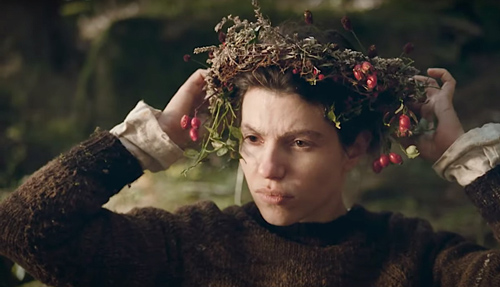
Don’t let the title fool you. Eighteenth-century fishmongers in Austria weren’t crazy about bathing. They did, however, have an undying fear of Satan and a gross misunderstanding of mental health. In The Devil’s Bath, Veronika Franz and Severin Fiala (Goodnight Mommy, The Lodge) covers just two of the hundreds of tragic, state-administered deaths from this period. The film’s as cold as it is sincere, and keen to illuminate one of the most prolific killers of all: tradition.
You might be inclined to liken The Devil’s Bath to Robert Eggers’ The Witch. And you wouldn’t be entirely wrong, especially given its opening sequence. In rural Austria during the late 1700s, a middle-aged woman plucks a baby from a random farm, carries it to the top of a waterfall and hurls it to its death. Then she turns herself in and is promptly executed.
Afterward, Agnes (Anja Plaschg, aka musician Soap&Skin), is married off by her mother and brother to Wolf (David Scheid), a local trapper. Unfortunately, neither quite fits the good Christian mold. Agnes’ quirks make her the frequent target of village gossip and her mother-in-law’s criticism. Wolf, on the other hand, seems much more interested in his friend, Lenz (Lorenz Tröbinger). Depression overtakes Agnes, and in the absence of any real help, she spirals toward a terrifying fate.

The Devil’s Bath occupies a similar space to Rose Glass’ Saint Maud. It doesn’t have the same God-talks-to-you-as-a-roach fever dreams, but this film hardly needs it. The horror lies in the murmurs of the townsfolk, prescriptive sermons and medical “treatments” in the form of leeches and bloodletting. It’s not so much a slow burn as it is a casual stride toward impending doom. From the moment we see Agnes playing with dead bugs, it’s clear she wasn’t meant long for this world.
Even so, The Devil’s Bath is more than a bleak examination of a helpless figure. It is that, to some extent, but it’s far from unearned brutality. Why Agnes doesn’t — or rather “can’t” — fit in is where the movie earns its runtime. She’s God-fearing, even to the point where her extended prayer time unnerves and annoys her community. Yet even this isn’t enough to steer their ire. An abyssal horn calls out roughly halfway through the film, as if signaling that no amount of church services and festivals overpower collective apathy.
It’s both crushing and cathartic. One powerful shot in particular sees silhouettes dancing around a bonfire. They pass through it, completely engulfed by flames, only to emerge from the other side — born and killed and born again but dancing all the same. For Agnes, the image reveals that freedom only exists through oblivion.
The Devil’s Bath could understandably come off as a little too direct for some. Its cinematography and commitment to historical accuracy keep it interesting, though it won’t leave you scratching your head, either. And in this case, straightforward storytelling works wonders, even if it leads straight to a put in your stomach.
Make no mistake: The Devil’s Bath is well worth a watch. Just brace yourself for the cold shower you’ll need afterward. —Daniel Bokemper

